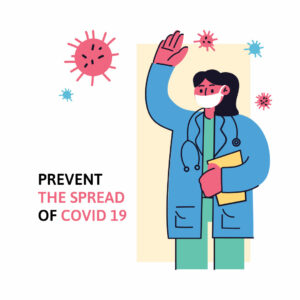Safety, health and hygiene are of extreme importance to human beings, especially in the testing times of Covid-19. Everyone wants to be as safe as possible under all circumstances and take minimal risk.
Elevators in the Covid-19 Pandemic
The Coronavirus which causes COVID-19 primarily spreads through droplets of saliva or nasal discharge when an infected person coughs or sneezes. Sometimes, when an infected person sneezes, he or she may cover their mouths with their hands and subsequently touch other surfaces.
The virus-laden droplets can also attach to surfaces, like elevator buttons and handrails and be transferred through touch.
Many have started using the staircase in lieu of elevators. However, in the case of high-rise buildings, or elderly users this may not be feasible.
Using the elevator in a safe and hygienic manner can mitigate the risk of acquiring coronavirus. By following a few simple operational procedures, users can be assured of their safety, and also help other lift users by leaving a safe elevator.
Here are ten operational tips that should be noted and adhered to when operating an elevator:

- Practice Social Distancing while Waiting for the elevator: Social Distancing must be followed at all times, including the time spent waiting for an elevator. Users must ideally maintain a distance of at least 3 feet between users. Floor markings at lift landings are a simple but effective way to ensure that users maintain social distancing while waiting for the elevator.
- Giving Way to Alighting Passengers: Passengers who plan to board the lift should first give way to alighting passengers before boarding. This will ensure that the passengers don’t have a face-to-face clash as they board (or disembark) from the elevator and will play a key role in facilitating social distancing among passengers.
- Traveling in Social Bubbles: Elevator Passengers who belong to a social bubble i.e. a family or a group that reside together should use the lift at the same time whenever possible. This reduces the exposure that the bubble will have as a whole with other people from outside the bubble.
- Wearing a Mask at all times: Everyone should wear a mask whenever they are outside the confines of their home. Passengers who do not wear a mask, should not use elevators as they will be putting their life and the life of others at risk in the process. In the case a passenger doesn’t have a mask, he or she should avoid the elevator altogether or travel on the elevator as a lone passenger.
- Keeping Away from Surfaces: After a tiring day at work, passengers may be tempted to lean on the hail railings or the body of the elevator. This should be avoided at all costs! The elevator car and body are made of metal and viruses can adhere to metallic surfaces for a considerable amount of time!
- Minimize the Number of Passengers: When the number of passengers traveling in a lift is less, the risk of exposure is reduced. It is best that only one passenger travels the lift at a given time. However, this may not be possible in all cases. Highrise office and residential buildings are used by thousands of users daily. Limiting the number of passengers in a lift car can help in minimizing the exposure to the virus. On the same note, as mentioned earlier passengers in the same social-bubble should use the lift at the same time.
- Using objects to touch buttons: It is best that lift users do not touch the buttons and other surfaces of the lift. Using an object like a key or stick to push the buttons is a better way. In the case passengers don’t have the access to a key or stick, they may use their elbow to press the button (since the elbow won’t contact the face or eyes of the passenger). Wearing latex or nitrile gloves is another option that can be considered in lieu of using objects.
- Hand Sanitation: Sanitation of hands before boarding and after alighting the lift is of extreme pertinence. Users need to ensure that they leave a clean lift for other passengers. Sanitizing the hand before boarding the lift ensures that passengers do not put others at risk. Sanitizing the hands after alighting ensures that passengers are safe even if they inadvertently touched a surface.
- Limiting the Number of Trips: Lift users need to limit the number of trips they take on the elevator. In high-rise residential buildings, residents may have to step out many times a day to collect deliveries, etc. Passengers need to try to coordinate and combine their activities to ensure that they limit the number of trips they take on the elevator. This ensures that they minimize the risk of exposure for themselves and other passengers.
- Avoiding Talking on Elevators: In offices and residences, it might be difficult to ignore a known passenger on the lift. However, talking on the lift should be avoided at all costs (unless absolutely necessary), in which case it should be kept as brief as possible. This will ensure that passenger interaction and exposure is minimized.
The Bottom Line
Covid-19, despite having caused considerable damage is yet to stay around for a while. By taking simple precautionary steps lift users can make the experience of using the lift safer for themselves and others.
In this new normal, we need to take significant steps to ensure the safety of ourselves, our loved ones and everyone around!







